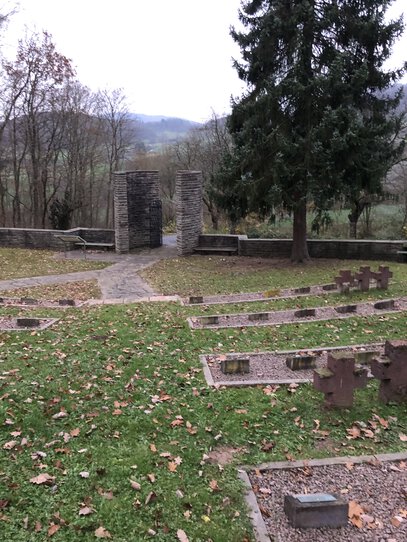Cemetery
You have now arrived at the last station of the QR code tour. Outside the monastery wall, about 500 metres from the institution, the institution's first cemetery was established in 1877. After several complaints about the neglected state of the cemetery, the property in front of you, right next to the cemetery of the municipality of Breitenau, was bought in 1926. Employees of the institution and their relatives were buried on the one side, and prisoners on the other. In order to save on burial costs, some of the dead were also taken to Marburg for anatomical research in the context of medical education. The institution was paid a certain amount per body. The victims of the "work education camp" (AEL) were also buried in the institution's cemetery. Among them was Willy Hermann Tietz, who was persecuted for anti-Semitic reasons and murdered on 23 April 1944.
A few weeks after the camp was liberated, the American military government also had the victims of an end-phase crime buried here. Twenty-eight men, who were Soviet, French and Dutch forced workers, had been murdered by the Gestapo a few hours before American soldiers arrived in late March 1945. At the beginning of the 1960s, the remains of a total of 48 persons were moved from the historic cemetery of the institution to the newly constructed Ludwigstein war memorial site near Witzenhausen. They were "foreign civilians"...
End-phase crime
On 30 March 1945, an end-phase crime was committed at the Fuldaberg, above the village of Guxhagen.
In the early hours of the morning, the Gestapo had apparently selected 30 prisoners at random. In groups of 10, these persons were led up to the Fuldaberg, lined up at a pit that had been dug by other prisoners and shot by members of the SS and the Gestapo. Two men managed to escape down the slopes of the Fuldaberg and through the Fulda river, one after the other. The 28 people murdered there were buried in the forest on the spot. On 21 April 1945, the American military government was informed by a former prisoner of the Breitenau work education camp (AEL) that a mass murder had taken place shortly before their arrival in Guxhagen. The military government then ordered the buried corpses to be exhumed and examined in the former roll-call area to establish their identity. However, identifying features could only be found on a few. Most of the dead were buried in the nearby cemetery of the institution.
Consequences for those responsible
The head of the Kassel Gestapo Franz Marmon and his deputy Erich Engels were responsible for the order of the end-phase crime and for its execution. Engels was picked up immediately after the end of the war and taken into custody. In 1947, he was transferred to Poland where he was sentenced to death and hanged in 1951. Marmon first disappeared with falsified papers and was arrested in 1950. After spending two years in custody, he was sentenced to two years in prison before the Kassel Regional Court in 1952 for ordering the mass shooting of the 28 prisoners and other mass killings. Since his time in custody between 1950 and 1952 was counted as time served, he was able to leave the courtroom a free man.


